Abstract
A chromogenic Limulus amoebocyte lysate assay was evaluated as a rapid screening test for the detection of clinically significant gram-negative bacteriuria. The development of a distinctive yellow color after the addition of chromogenic substrate to the Limulus amoebocyte lysate-urine reaction mixture was used to measure greater than or equal to 10(5) gram-negative bacteria per ml. A total of 324 urine specimens were assayed, with 68 gram-negative urinary tract infections identified as defined by quantitative urine colony counts of greater than or equal to 10(5) bacteria per ml. Of these, 68 and 67 of 68 were detected by the chromogenic Limulus amoebocyte lysate assay at urine dilutions of 1:10 and 1:20, respectively. Nine false-positive chromogenic Limulus amoebocyte lysate assay results were observed at both urine dilutions and in the same specimens. At a urine dilution of 1:10, sensitivity and specificity were 100 and 96.6%, respectively, with predictive values of 100% for a negative test and 88.3% for a positive test. At a urine dilution of 1:20, sensitivity and specificity were 98.6 and 96.6%, respectively; predictive values were 99.6% for a negative test and 88.3% for a positive test. These data suggest that chromogenic Limulus amoebocyte lysate assay of urine has potential usefulness as a rapid, reliable, and easily performed and interpreted screening test for the diagnosis of clinically significant gram-negative bacteriuria.
Full text
PDF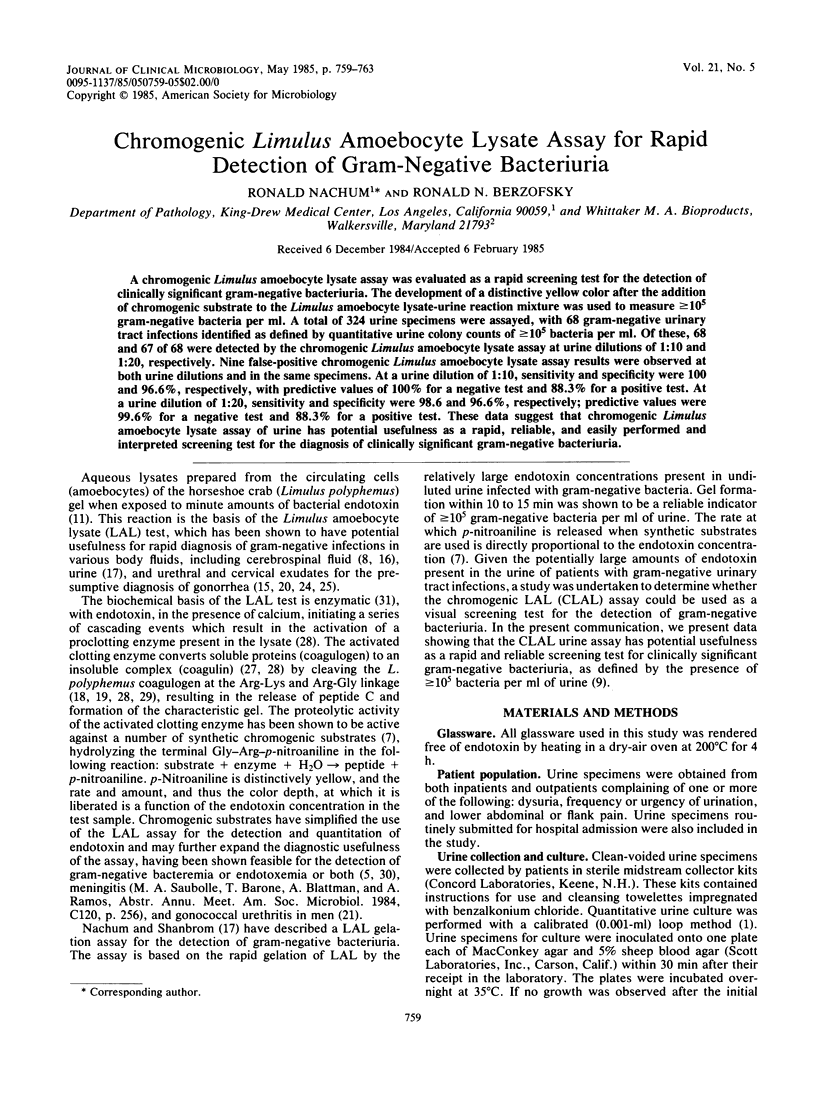
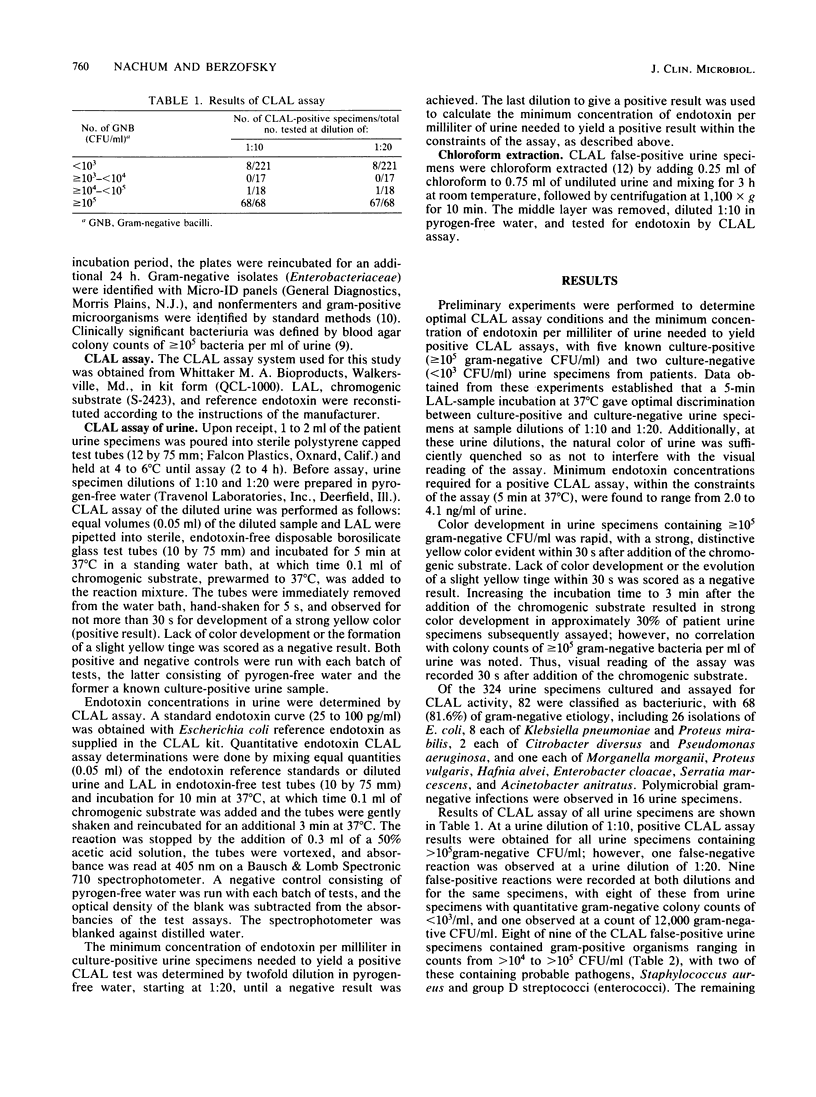
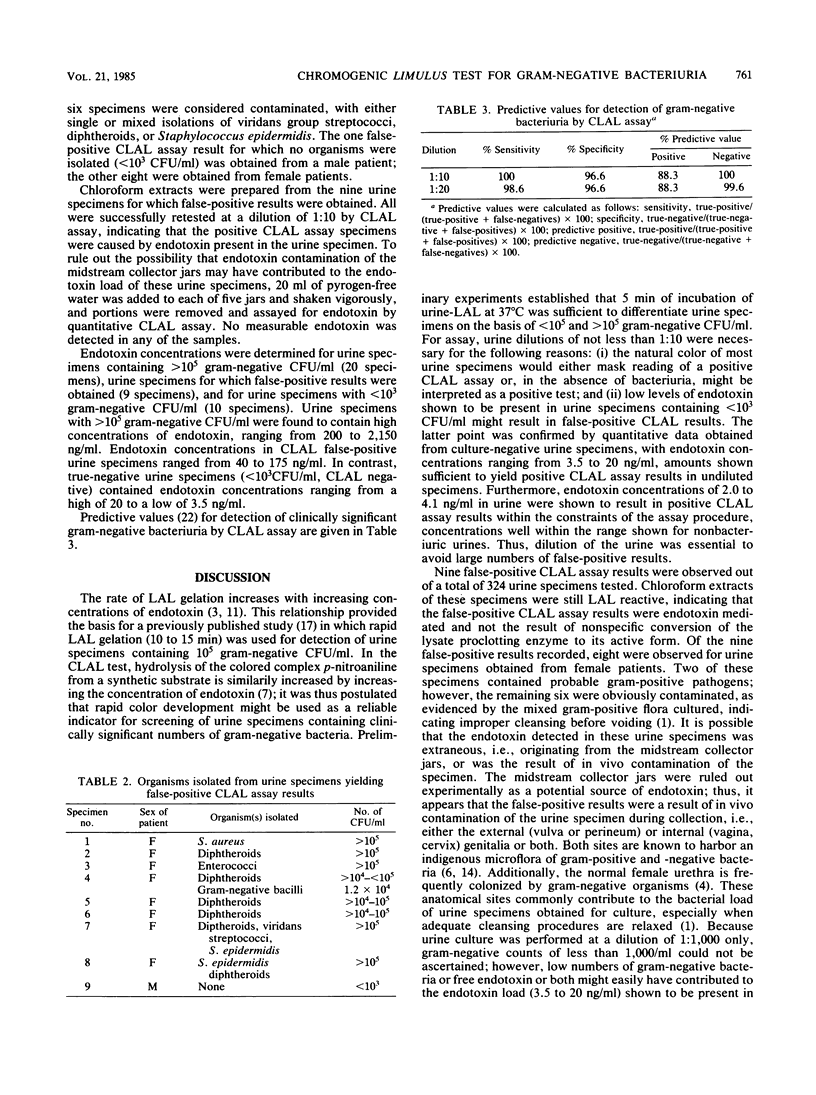
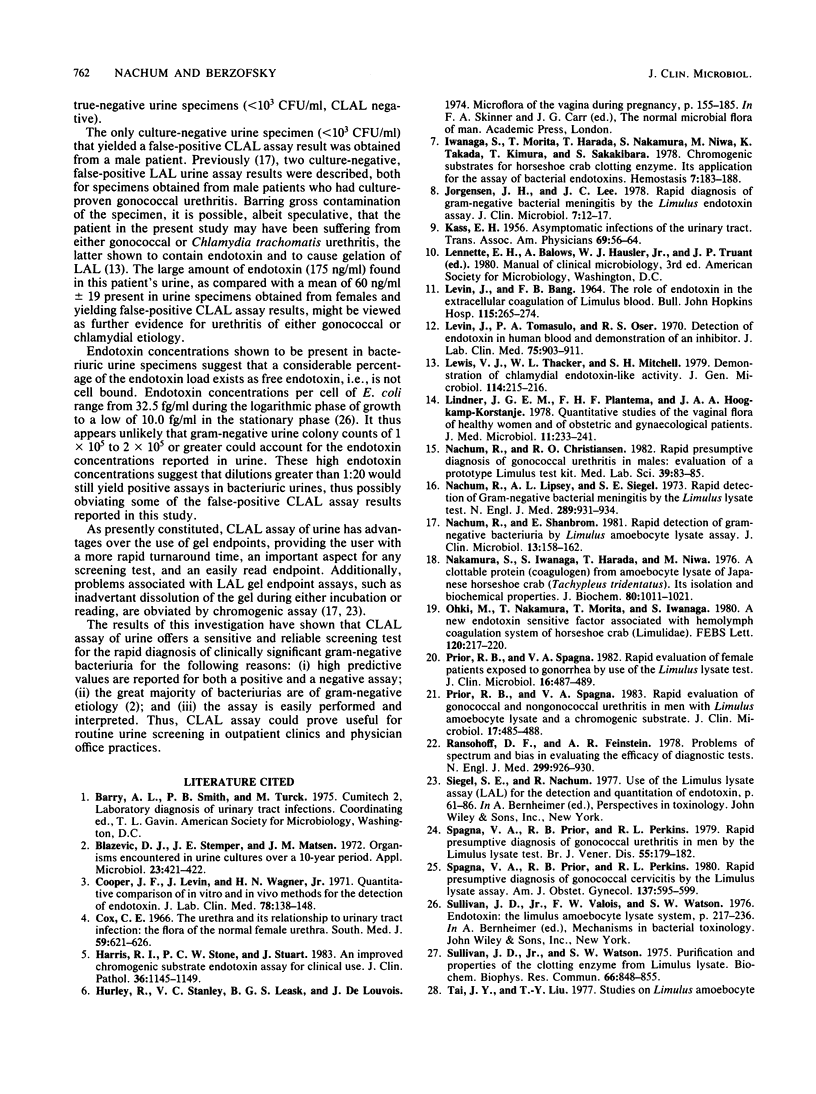
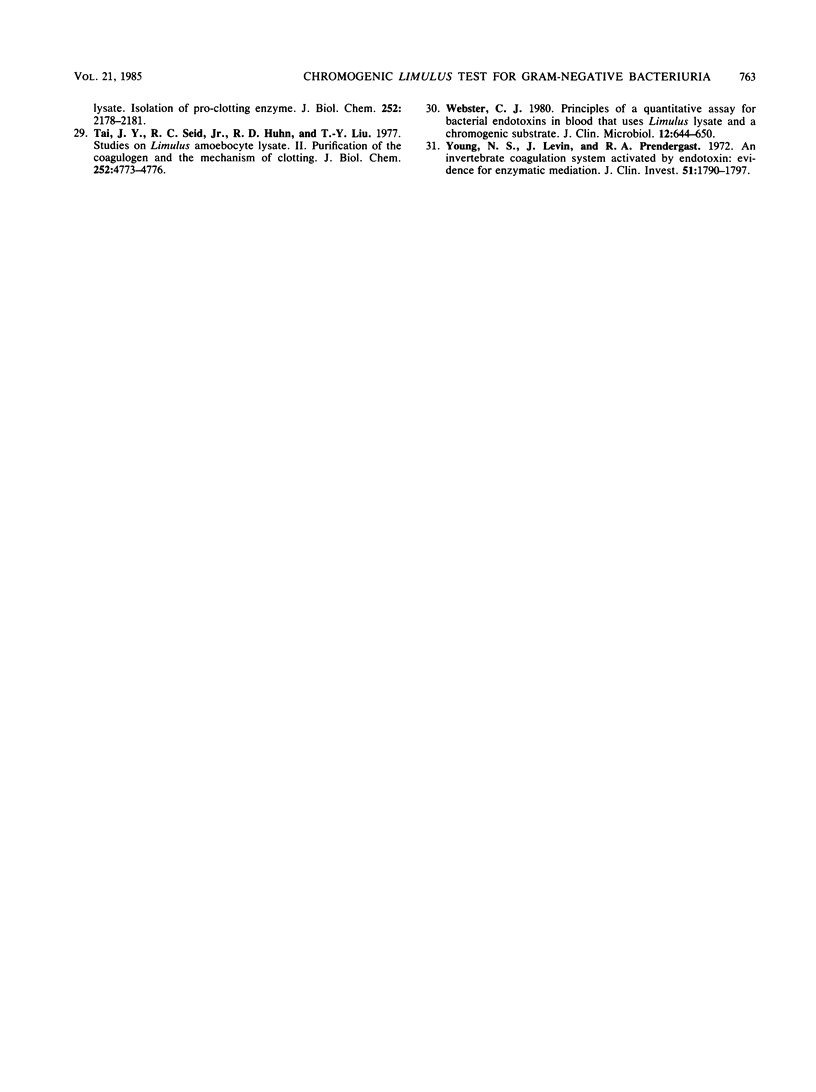
Selected References
These references are in PubMed. This may not be the complete list of references from this article.
- Blazevic D. J., Stemper J. E., Matsen J. M. Organisms encountered in urine cultures over a 10-year period. Appl Microbiol. 1972 Feb;23(2):421–422. doi: 10.1128/am.23.2.421-422.1972. [DOI] [PMC free article] [PubMed] [Google Scholar]
- Cooper J. F., Levin J., Wagner H. N., Jr Quantitative comparison of in vitro and in vivo methods for the detection of endotoxin. J Lab Clin Med. 1971 Jul;78(1):138–148. [PubMed] [Google Scholar]
- Cox C. E. The urethra and its relationship to urinary tract infection: the flora of the normal female urethra. South Med J. 1966 May;59(5):621–626. doi: 10.1097/00007611-196605000-00027. [DOI] [PubMed] [Google Scholar]
- Harris R. I., Stone P. C., Stuart J. An improved chromogenic substrate endotoxin assay for clinical use. J Clin Pathol. 1983 Oct;36(10):1145–1149. doi: 10.1136/jcp.36.10.1145. [DOI] [PMC free article] [PubMed] [Google Scholar]
- Hurley R., Stanley V. C., Leask B. G., De Louvois J. Microflora of the vagina during pregnancy. Soc Appl Bacteriol Symp Ser. 1974;3(0):155–185. [PubMed] [Google Scholar]
- Iwanaga S., Morita T., Harada T., Nakamura S., Niwa M., Takada K., Kimura T., Sakakibara S. Chromogenic substrates for horseshoe crab clotting enzyme. Its application for the assay of bacterial endotoxins. Haemostasis. 1978;7(2-3):183–188. doi: 10.1159/000214260. [DOI] [PubMed] [Google Scholar]
- Jorgensen J. H., Lee J. C. Rapid diagnosis of gram-negative bacterial meningitis by the Limulus endotoxin assay. J Clin Microbiol. 1978 Jan;7(1):12–17. doi: 10.1128/jcm.7.1.12-17.1978. [DOI] [PMC free article] [PubMed] [Google Scholar]
- KASS E. H. Asymptomatic infections of the urinary tract. Trans Assoc Am Physicians. 1956;69:56–64. [PubMed] [Google Scholar]
- LEVIN J., BANG F. B. THE ROLE OF ENDOTOXIN IN THE EXTRACELLULAR COAGULATION OF LIMULUS BLOOD. Bull Johns Hopkins Hosp. 1964 Sep;115:265–274. [PubMed] [Google Scholar]
- Levin J., Tomasulo P. A., Oser R. S. Detection of endotoxin in human blood and demonstration of an inhibitor. J Lab Clin Med. 1970 Jun;75(6):903–911. [PubMed] [Google Scholar]
- Lewis V. J., Thacker W. L., Mitchell S. H. Demonstration of chlamydial endotoxin-like activity. J Gen Microbiol. 1979 Sep;114(1):215–216. doi: 10.1099/00221287-114-1-215. [DOI] [PubMed] [Google Scholar]
- Lindner J. G., Plantema F. H., Hoogkamp-Korstanje J. A. Quantitative studies of the vaginal flora of healthy women and of obstetric and gynaecological patients. J Med Microbiol. 1978 Aug;11(3):233–241. doi: 10.1099/00222615-11-3-233. [DOI] [PubMed] [Google Scholar]
- Nachum R., Christiansen R. O. Rapid presumptive diagnosis of gonococcal urethritis in males: evaluation of a prototype limulus lysate test kit. Med Lab Sci. 1982 Jan;39(1):83–85. [PubMed] [Google Scholar]
- Nachum R., Lipsey A., Siegel S. E. Rapid detection of gram-negative bacterial meningitis by the limulus lysate test. N Engl J Med. 1973 Nov 1;289(18):931–934. doi: 10.1056/NEJM197311012891801. [DOI] [PubMed] [Google Scholar]
- Nachum R., Shanbrom E. Rapid detection of Gram-negative bacteriuria by Limulus amoebocyte lysate assay. J Clin Microbiol. 1981 Jan;13(1):158–162. doi: 10.1128/jcm.13.1.158-162.1981. [DOI] [PMC free article] [PubMed] [Google Scholar]
- Nakamura S., Iwanaga S., Harada T., Niwa M. A clottable protein (coagulogen) from amoebocyte lysate of Japanese horseshoe crab (Tachypleus tridentatus). Its isolation and biochemical properties. J Biochem. 1976 Nov;80(5):1011–1021. doi: 10.1093/oxfordjournals.jbchem.a131357. [DOI] [PubMed] [Google Scholar]
- Ohki M., Nakamura T., Morita T., Iwanaga S. A new endotoxin sensitive factor associated with hemolymph coagulation system of horseshoe crab (Limulidae). FEBS Lett. 1980 Nov 3;120(2):217–220. doi: 10.1016/0014-5793(80)80301-2. [DOI] [PubMed] [Google Scholar]
- Prior R. B., Spagna V. A. Rapid evaluation of female patients exposed to gonorrhea by use of the Limulus lysate test. J Clin Microbiol. 1982 Sep;16(3):487–489. doi: 10.1128/jcm.16.3.487-489.1982. [DOI] [PMC free article] [PubMed] [Google Scholar]
- Prior R. B., Spagna V. A. Rapid evaluation of gonococcal and nongonococcal urethritis in men with Limulus amoebocyte lysate and a chromogenic substrate. J Clin Microbiol. 1983 Mar;17(3):485–488. doi: 10.1128/jcm.17.3.485-488.1983. [DOI] [PMC free article] [PubMed] [Google Scholar]
- Ransohoff D. F., Feinstein A. R. Problems of spectrum and bias in evaluating the efficacy of diagnostic tests. N Engl J Med. 1978 Oct 26;299(17):926–930. doi: 10.1056/NEJM197810262991705. [DOI] [PubMed] [Google Scholar]
- Spagna V. A., Prior R. B., Perkins R. L. Rapid presumptive diagnosis of gonococcal cervicitis by the limulus lysate assay. Am J Obstet Gynecol. 1980 Jul 1;137(5):595–599. doi: 10.1016/0002-9378(80)90702-4. [DOI] [PubMed] [Google Scholar]
- Spagna V. A., Prior R. B., Perkins R. L. Rapid presumptive diagnosis of gonococcal urethritis in men by the limulus lysate test. Br J Vener Dis. 1979 Jun;55(3):179–182. doi: 10.1136/sti.55.3.179. [DOI] [PMC free article] [PubMed] [Google Scholar]
- Sullivan J. D., Jr, watson S. W. Purification and properties of the clotting enzyme from Limulus lysate. Biochem Biophys Res Commun. 1975 Sep 16;66(2):848–855. doi: 10.1016/0006-291x(75)90587-2. [DOI] [PubMed] [Google Scholar]
- Tai J. Y., Seid R. C., Jr, Huhn R. D., Liu T. Y. Studies on Limulus amoebocyte lysate II. Purification of the coagulogen and the mechanism of clotting. J Biol Chem. 1977 Jul 25;252(14):4773–4776. [PubMed] [Google Scholar]
- Webster C. J. Principles of a quantitative assay for bacterial endotoxins in blood that uses Limulus lysate and a chromogenic substrate. J Clin Microbiol. 1980 Nov;12(5):644–650. doi: 10.1128/jcm.12.5.644-650.1980. [DOI] [PMC free article] [PubMed] [Google Scholar]
- Young N. S., Levin J., Prendergast R. A. An invertebrate coagulation system activated by endotoxin: evidence for enzymatic mediation. J Clin Invest. 1972 Jul;51(7):1790–1797. doi: 10.1172/JCI106980. [DOI] [PMC free article] [PubMed] [Google Scholar]


